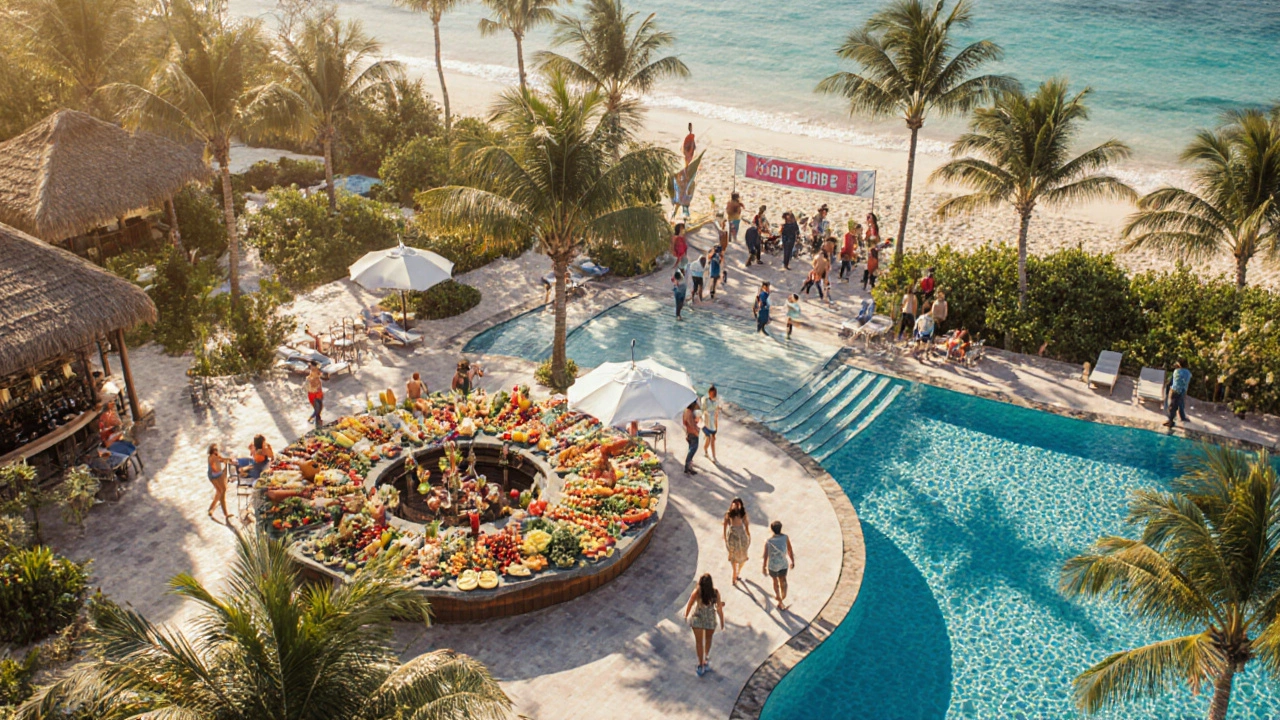All-Inclusive Cost Calculator
Your All-Inclusive Details
Your À La Carte Details
Important Notes
Check your package details for hidden costs like premium alcohol, spa treatments, and resort fees. Some resorts charge extra for excursions or Wi-Fi. The calculator assumes you'll use the resort's standard beverage package for all-inclusive stays.
Key Takeaways
- All‑inclusive hotels can be cheaper, but only when you factor in meals, drinks, activities and hidden fees.
- Compare the total daily cost of an all‑inclusive stay with an à la carte option for the same destination.
- Watch out for extra charges such as premium alcohol, spa treatments, and resort taxes.
- Use a simple spreadsheet or online calculator to model your personal travel budget.
- Book during off‑peak periods and negotiate with the resort to squeeze the most value out of the package.
What Exactly Is an All‑Inclusive Hotel?
When you book All-Inclusive Hotels properties that bundle accommodation, meals, drinks and most on‑site activities into a single price, the idea is simple: you pay once, you eat, drink and play without reaching for your wallet. The package usually covers:
- Room rate (including taxes and resort fees)
- All meals - breakfast, lunch, dinner, and often a snack bar
- Unlimited soft drinks, water, and often local spirits
- Access to pools, gyms, organized entertainment, and sometimes water sports
What’s missing varies from brand to brand, which is why the "cheaper" question needs a deeper look.
How Does an À La Carte Hotel Work?
In contrast, an À La Carte Hotels properties where you pay for accommodation only and purchase food, drinks and activities separately let you pick and choose. You might stay in a boutique hotel with a stunning view, then dine at local restaurants and pay for excursions as you go.
Because each cost is separate, you have more flexibility - but you also face the risk of a bill that balloons beyond your original budget.
Breaking Down the Numbers
Let’s run a quick math exercise for a popular Caribbean resort. Assume a 7‑night stay for two adults.
| Item | All‑Inclusive | À La Carte |
|---|---|---|
| Room Rate (incl. taxes) | $1,200 | $800 |
| Meals & Drinks | Included | $700 (average $100/day) |
| Activities (snorkeling, shows, gym) | Included | $250 (guided tours, rentals) |
| Premium Alcohol & Spa | $120 (average consumption) | $120 (same) |
| Resort Tax / Service Charge | $150 | $150 |
| Total | $1,470 | $2,120 |
In this scenario the all‑inclusive package saves about $650. The biggest gap comes from meals and drinks - a typical traveler who eats three meals a day in a tourist hotspot can easily exceed $100 per day.

Hidden Costs That Can Flip the Equation
Even a well‑structured package can hide fees. Keep an eye on these:
- Premium Alcohol specialty drinks, top‑shelf spirits, or bottle service not covered by the standard beverage package
- Spa Treatments massages, facials, and wellness services usually charged at full price
- Internet fees - many resorts charge per device or per day for Wi‑Fi.
- Excursions off‑property - island tours, wildlife safaris, or cultural shows often cost extra.
- Currency exchange rate swings - if you’re paying in a foreign currency, a drop in the exchange rate can erode any savings.
Factor these into your spreadsheet before you declare a winner.
When an All‑Inclusive Deal Really Pays Off
All‑inclusive tends to win in three main situations:
- Food‑centric travelers: If you love eating out for every meal, the bundled meals cut the per‑day cost dramatically.
- Families with kids: Children’s meals, snacks, and supervised activities are usually free or heavily discounted.
- Travelers on a strict budget: Knowing the ceiling price helps you avoid surprise charges that can bust your budget.
In each case the predictability of the all‑inclusive price outweighs the flexibility of à la carte.
How to Crunch Your Own Numbers
Here’s a simple step‑by‑step method you can copy into a spreadsheet:
- List the nightly room rate for the all‑inclusive resort (include taxes).
- Multiply by the number of nights to get the base accommodation cost.
- Add estimated daily food & drink cost if you were eating out (use local restaurant averages).
- Add typical activity fees you expect to pay off‑property.
- Include any known extra fees (premium alcohol, spa, internet).
- Do the same calculation for an à la carte hotel, starting with its lower room rate.
- Compare the totals. The lower figure is your cost‑effective choice.
For added accuracy, pull recent Currency Exchange Rate the conversion rate between your home currency and the destination’s money from a reputable source like Bloomberg or Reuters.
Pro Tips to Get the Best All‑Inclusive Value
- Book during shoulder season - you still get the same amenities but at a lower price.
- Ask the resort to waive resort fees or upgrade your room category for free.
- Check if the package includes airport transfers - those can add $50‑$100 per person.
- Enroll in the hotel’s loyalty program; many chains offer complimentary upgrades to all‑inclusive tiers.
- Watch out for “all‑inclusive + ” labels - the plus often signals premium dining or exclusive clubs that cost extra.
Implementing even a couple of these tricks can shrink the total cost by 10‑15%.
Common Pitfalls and How to Avoid Them
Even seasoned travelers slip into these traps:
- Assuming all drinks are free - many resorts cap premium spirits at a certain number per day.
- Skipping the fine print - some all‑inclusive deals exclude “off‑site” excursions, meaning you’ll still pay for a boat ride.
- Over‑booking activities - you might sign up for every evening show, then realize you’re exhausted and waste money.
- Ignoring local taxes - resort fees can be as high as 15% of the room rate and are sometimes added post‑checkout.
Read the package brochure line‑by‑line, and ask a reservation agent to clarify anything that seems vague.
Bottom Line - Is It Cheaper?
Short answer: Yes, for most families and food‑focused travelers, an all‑inclusive hotel can be cheaper than piecing together every component separately. Long answer: it depends on your personal spending habits, the destination’s cost of living, and the exact terms of the package.
Run the simple cost model above, factor in hidden fees, and you’ll know whether the all‑inclusive route truly saves you money.
What’s the main advantage of all‑inclusive hotels?
The primary benefit is price predictability - you pay one price and know that meals, drinks, and most activities are covered, which helps keep the total vacation cost within budget.
Are children always free at all‑inclusive resorts?
Many chains offer free meals and activities for kids under a certain age, but you should verify the policy because some resorts charge a reduced rate or limit certain amenities.
How can I avoid paying extra for premium alcohol?
Check the fine print before you book. Some resorts cap premium spirit consumption at a set number of drinks per day; if you exceed that, you’ll be charged per drink. Ask the concierge about any surcharge policies.
Is it worth comparing all‑inclusive prices across multiple destinations?
Absolutely. The cost of a comparable all‑inclusive package can vary dramatically between Caribbean islands, Mediterranean coasts, and Mexican resorts. Use a spreadsheet to compare total daily costs, including taxes and optional extras.
What should I do if the resort’s all‑inclusive package seems cheaper than the local cost of living?
A surprisingly low price can signal limited amenities or hidden restrictions. Verify what’s included, read recent guest reviews, and confirm there are no extra resort taxes that will be added later.
